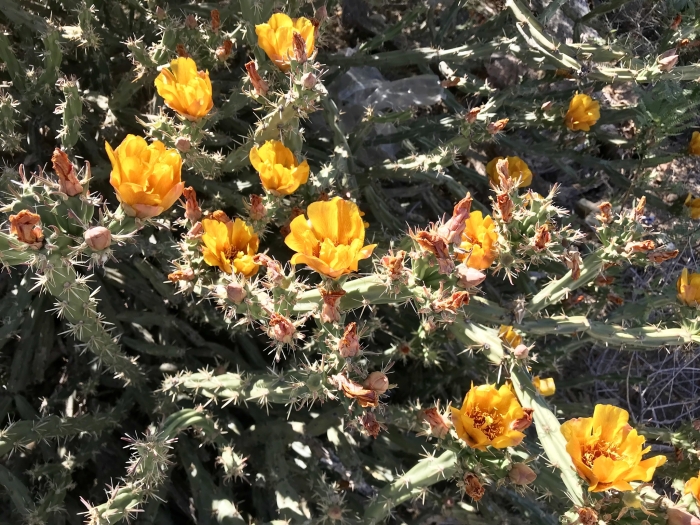Buckhorn Cholla
(Cylindropuntia acanthocarpa)
Buckhorn Cholla (Cylindropuntia acanthocarpa)
/
/

CK Kelly
CC BY 4.0
Image By:
CK Kelly
Recorded By:
Copyright:
CC BY 4.0
Copyright Notice:
Photo by: CK Kelly | License Type: CC BY 4.0 | License URL: http://creativecommons.org/licenses/by/4.0/ | Rights Holder: CK Kelly | Publisher: iNaturalist | Date Created: 2018-05-08T21:59:49Z |
































































Estimated Native Range
Summary
Cylindropuntia acanthocarpa, commonly known as Buckhorn Cholla, is a deciduous succulent native to the Sonoran and Mojave Deserts, as well as desert scrub and arid grasslands in Arizona, California, Nevada, and Utah. It typically grows to a height of 3-5 feet (0.9-1.5 meters) with a branching, tree-like structure. The plant is characterized by its cylindrical, jointed stems covered in spines, and it produces vibrant red, yellow, and orange flowers in the late spring to early summer. The flowers are quite showy and attract pollinators such as bees. After flowering, it bears yellowish fruits that are dry and spiny.
Buckhorn Cholla is valued for its unique sculptural form and colorful flowers, making it a striking addition to xeriscapes and desert gardens. It is also used in habitat restoration projects. This cholla is adapted to extreme conditions and requires minimal maintenance once established. It thrives in full sun and needs very little water, making it an excellent choice for water-wise gardening. It prefers well-drained soils and is tolerant of poor soil conditions. While generally disease-free, it can be susceptible to root rot if overwatered. Gardeners should handle this plant with care due to its sharp spines, and it is advisable to plant it away from high-traffic areas.CC BY-SA 4.0
Buckhorn Cholla is valued for its unique sculptural form and colorful flowers, making it a striking addition to xeriscapes and desert gardens. It is also used in habitat restoration projects. This cholla is adapted to extreme conditions and requires minimal maintenance once established. It thrives in full sun and needs very little water, making it an excellent choice for water-wise gardening. It prefers well-drained soils and is tolerant of poor soil conditions. While generally disease-free, it can be susceptible to root rot if overwatered. Gardeners should handle this plant with care due to its sharp spines, and it is advisable to plant it away from high-traffic areas.CC BY-SA 4.0
Plant Description
- Plant Type: Succulent
- Height: 2-4 feet
- Width: 4-5 feet
- Growth Rate: Moderate
- Flower Color: Red, Yellow, Orange
- Flowering Season: Spring
- Leaf Retention: Deciduous
Growth Requirements
- Sun: Full Sun
- Water: Very Low, Low
- Drainage: Fast
Common Uses
Bee Garden, Drought Tolerant, Erosion Control, Fire Resistant, Low Maintenance, Showy Flowers
Natural Habitat
Native to the Sonoran and Mojave Deserts, desert scrub, and arid grasslands in Arizona, California, Nevada, and Utah
Other Names
Common Names:
Scientific Names: , Cylindropuntia acanthocarpa, Cylindropuntia acanthocarpa var. acanthocarpa,
GBIF Accepted Name: Cylindropuntia acanthocarpa (Engelm. & Bigelow) F.M.Knuth